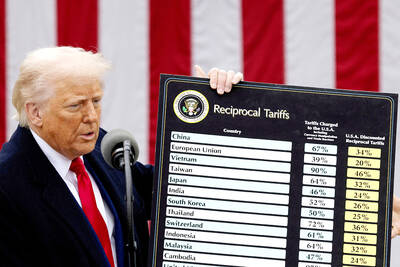Likely losses from the financial crisis in the three years to next year have been reduced by US$600 billion to US$3.4 trillion as the world economy grows faster than previously expected, the IMF said yesterday.
The organization said however that the impetus for far-reaching financial reforms risked being lost if the improving situation leads to complacency.
In its half-yearly Global Financial Stability Report presented in Istanbul, Turkey, the fund said concerted efforts by governments and central banks to deal with the crisis and fledgling signs of a global economic recovery have helped limit the losses.
“Systemic risks have been substantially reduced following unprecedented policy actions and nascent signs of improvement in the real economy,” the IMF report said.
“There is growing confidence that the global economy has turned the corner, underpinning the improvements in financial markets,” it said.
The IMF said its analysis suggests that US banks are more than halfway through the loss cycle to next year, whereas in Europe loss recognition is less advanced, reflecting differences in the regions’ economic cycles.
A top IMF official said that the conference in Istanbul was taking place just over a year since the Lehman Brothers bankruptcy triggered the sharpest phase of the global financial crisis.
“Fortunately, the situation is very different today,” said Jose Vinals, IMF financial counselor and director of the monetary and capital markets department. “We are on the road to recovery, but it doesn’t mean that risks have disappeared.”
“Bank balance sheets have been stabilized,” Vinals said. But “there is still a substantial need for capital” to safeguard the financial system.
The IMF’s reassessment of the potential losses stemming from the financial crisis comes ahead of today’s World Economic Outlook, when the fund will publish its latest estimates for the global economy.
In yesterday’s report, the IMF indicated the outlook would raise its baseline forecast for global growth, with advanced economies expected to register positive growth next year, and emerging economies projected to rebound significantly.
Most analysts expect today’s report to show that next year’s global growth will be revised up to 3 percent from 2.5 percent.
Despite its more optimistic assessment of the financial fallout from the crisis, the IMF warned that risks to global stability remained high and that banks still need to rebuild their capital, strengthen earnings and wean themselves off government support.
Commercial property markets in the US and Europe also continue to weaken, the IMF said.
In particular, the IMF said governments and central banks have to be careful to make sure they time the withdrawal of their assistance carefully, otherwise they could spark a secondary crisis or endanger monetary and fiscal stability.
It also said that complacency was a worry.
“Banking system problems could go unresolved and much-needed regulatory reforms may be delayed or diluted,” it said. “Policymakers should promptly provide a plan for the future regulatory framework that mitigates the buildup of systemic risks, grounds expectations, and underpins confidence, thereby contributing to sustained economic growth.”

Rainfall is expected to become more widespread and persistent across central and southern Taiwan over the next few days, with the effects of the weather patterns becoming most prominent between last night and tomorrow, the Central Weather Administration (CWA) said yesterday. Independent meteorologist Daniel Wu (吳德榮) said that based on the latest forecast models of the combination of a low-pressure system and southwesterly winds, rainfall and flooding are expected to continue in central and southern Taiwan from today to Sunday. The CWA also warned of flash floods, thunder and lightning, and strong gusts in these areas, as well as landslides and fallen

WAITING GAME: The US has so far only offered a ‘best rate tariff,’ which officials assume is about 15 percent, the same as Japan, a person familiar with the matter said Taiwan and the US have completed “technical consultations” regarding tariffs and a finalized rate is expected to be released soon, Executive Yuan spokeswoman Michelle Lee (李慧芝) told a news conference yesterday, as a 90-day pause on US President Donald Trump’s “reciprocal” tariffs is set to expire today. The two countries have reached a “certain degree of consensus” on issues such as tariffs, nontariff trade barriers, trade facilitation, supply chain resilience and economic security, Lee said. They also discussed opportunities for cooperation, investment and procurement, she said. A joint statement is still being negotiated and would be released once the US government has made

SOUTH CHINA SEA? The Philippine president spoke of adding more classrooms and power plants, while skipping tensions with China over disputed areas Philippine President Ferdinand Marcos Jr yesterday blasted “useless and crumbling” flood control projects in a state of the nation address that focused on domestic issues after a months-long feud with his vice president. Addressing a joint session of congress after days of rain that left at least 31 dead, Marcos repeated his recent warning that the nation faced a climate change-driven “new normal,” while pledging to investigate publicly funded projects that had failed. “Let’s not pretend, the people know that these projects can breed corruption. Kickbacks ... for the boys,” he said, citing houses that were “swept away” by the floods. “Someone has

‘CRUDE’: The potential countermeasure is in response to South Africa renaming Taiwan’s representative offices and the insistence that it move out of Pretoria Taiwan is considering banning exports of semiconductors to South Africa after the latter unilaterally downgraded and changed the names of Taiwan’s two representative offices, the Ministry of Foreign Affairs (MOFA) said yesterday. On Monday last week, the South African Department of International Relations and Cooperation unilaterally released a statement saying that, as of April 1, the Taipei Liaison Offices in Pretoria and Cape Town had been renamed the “Taipei Commercial Office in Johannesburg” and the “Taipei Commercial Office in Cape Town.” Citing UN General Assembly Resolution 2758, it said that South Africa “recognizes the People’s Republic of China (PRC) as the sole